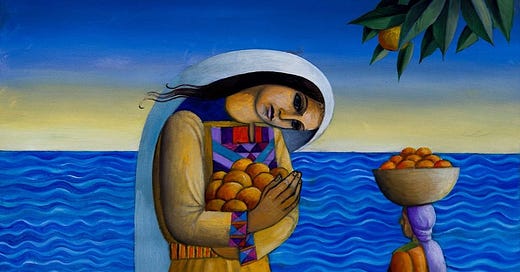In the Olive Grove
Dear art seekers,
My apologies for disappearing for a while. With the busy flow of life and ongoing changes, it would be more suitable for this to become a bi-weekly newsletter. Like a lot of people, my spirits have been down since the Israeli war on Gaza began. What a horrible time to be a human being. And to feel so helpless. This certainly is bigger than any of us and unfortunately, a lot of power lies in the wrong set of hands. But we’re not that useless, we can educate ourselves and others on the truth of the situation. This isn’t just a political crisis, it is a humanitarian one.
As artists, we always resort to art during hard times. A friend of mine reminded me of one of my absolute favorite artists. Seeing this work amid chaos felt like that rare breeze of air on a scorching hot day. In its unique way, it gave me a moment of solace. Sliman Mansour is a distinguished and renowned Palestinian artist born in Birzeit in 1947, a year before the Nakba. Bir-Zeit (olive oil) got its name from having a lot of olive trees around it. Mansour’s work is unique in its use of symbols that symbolize Palestinian’s attachment to the land and their resistance. His paintings are a window into the narrative of the land and the uprootedness that Palestinians endure. His use of oranges represents land lost in the Nakba of 1948 such as in Lost Sea II (2015) (fig.1) where a Palestinian woman is hugging a bundle of oranges. Mansour expresses this collective heartache through the simple gesture of a hug. Through this painting lies more symbolism. The women wearing traditional embroidered dresses represent Palestinian land and the Palestinian revolution.
With olive trees, he represents land occupied in 1967. In Olive Harvest (1988) (fig.2) Mansour paints a man and woman harvesting olives as part of their annual tradition. Here he depicts his figures on their land.
However, in Memory of Places (2009) (fig.3), Mansour paints his figure standing outside of his land, as if it's nothing but a framed memory.
In the 70’s Sliman and a group of other artists in the West Bank and Gaza tried to form a union but Israelis refused to permit them to work as a union. Despite that, they traveled to various countries, including Lebanon, Jordan, Japan, and the United States to showcase a collective exhibition of their work. Unfortunately, some of their work was never returned to them. One of his most valued paintings titled Camel of Hardships (1974) (fig.4) was a victim to the stolen artworks.
During the first Intifada against Israeli occupation (1987 – 1993) Mansour and other artists in the ‘New Vision’ art movement started to boycott Israeli supplies. This boycott led Mansour to transition into using mud as a medium for his art. He didn’t like the cracks that resulted from the mud but eventually leaned into it as seen in Shrinking Object (1996) (fig.5).
I could go on and on about Mansour’s work, there is so much to admire. His work takes my breath away. I sometimes find myself in the middle of his olive grove and other times next to his orange trees. It transports me back to my own home.
If you are interested in listening to an in-depth conversation with Sliman Mansour, then you should check out this great podcast episode with afikra. Also, check out some of Mansour’s work on his website and maybe treat yourself to a print? I know I will.
I hope everyone has a wonderful week channeled with positivity!
Sincerely,
Rebecca







